
Edward Winter

José Raúl Capablanca in Havana (C.N.s 3674 and 3675)
The first part of this article focuses on the rapidity of Capablanca’s play in simultaneous exhibitions. The second part comprises photographs of his displays which have appeared in C.N. over the years.
A detailed account of Capablanca’s speed in simultaneous play, at a display on 12 February 1915, was given on pages 42-44 of the March 1915 American Chess Bulletin:
‘The Cuban champion played at 65 boards against 84 opponents, singly and in consultation, making a score of 48 wins, 5 losses and 12 drawn games in the space of 6¾ hours.
… Capablanca consumed an average of about ten minutes for the first 40 rounds, during which most of the players were still in line. His first round took nine minutes, the next 10, 11 and 14 minutes, respectively. The longest time for the circuit of the boards was 20¼ minutes for the ninth round. Thereafter the time see-sawed between 16 and 17 until the 19th round, when it went down to 13½. With only nine players in line, the Cuban got around in two minutes.’
A vivid description of Capablanca’s physical appearance at a simultaneous exhibition was written by A.W. Foster on page 50 of the November 1913 Chess Amateur:
‘Quietly, without fuss or ostentation, he walked round: smoothly is perhaps the word which fits most closely with his manner of doing it: there was no shower of quips and cranks from Capablanca – “the play’s the thing”. You could see that he had forgotten all the incidents of physical existence, and, for the time being, was an incarnation of pure intelligence. For him, his body did not exist: he was a detached intelligence, moving about in a physical framework of which it was unconscious. Tricks and mannerisms, with Capablanca, are few, but characteristic. Confronted with complications, he gathers up his lower lip between thumb and finger, pensively rubs the tip of his nose, and, last resort of all, ruffles up his hair. Then, having made his move, he steps to the next board, his glance still lingering on the one he has just left, as if the full effect of the move he has just made were sinking into his brain.’
(Kingpin, 2000)
Page 106 of the March 1911 La Stratégie had an account of a simultaneous display given by Capablanca on 25 March 1911:
‘To conclude the evening, Capablanca tackled eight games against various strong amateurs from the Café de la Régence; some fought alone while others grouped together. The young American master played with truly surprising rapidity, since in exactly 22 minutes (!) he had finished on the eight boards, winning seven games and losing only to Mr Halberstam.’
(Kingpin, 2000)
Pages 451-452 of the Chess Amateur, December 1911 had a description of Capablanca’s first two simultaneous exhibitions in England (at the City of London Chess Club on 15 November and at the Imperial Chess Club two days later). In the first display his opponents included J.H. Blake, H.G. Cole, R. Loman and O.C. Müller, but it would seem that The Unknown Capablanca by D. Hooper and D. Brandreth (London, 1975) erred by stating (on page 146) that among the participants was also ‘one grandmaster, H.E. Atkins’. Neither the Chess Amateur report nor the account in the BCM (December 1911 issue, pages 474-475) mentioned H.E. Atkins, but both stated that a board was taken by M.G. Atkins.
Page 401 of the December 1916 BCM had an obituary of the latter which began:
‘It is with much regret that we record the death, through wounds received in the fighting-line in France, of Michael Glover Atkins, of the City of London Chess Club.’
With respect to the display on 17 November, the Chess Amateur gave this description:
‘Visitors and players alike were impressed no less by Capablanca’s boyish appearance than by the effectiveness of his play, and the quiet and apparently effortless manner in which it was conducted. His combinations seemed quite intuitive, the instantaneousness of his moves precluding calculation. He is, however, gifted with extraordinarily quick perception, and no doubt sees far into the possibilities of a position at a glance. Everyone was surprised by his instinctive selection of the right course in situations with intricate alternatives. His openings were varied and his speed was assisted by sometimes getting in two or three moves on a visit to a board when the opposing player had no occasion to hesitate over forced or evident replies. There was an enthusiastic demonstration at the end of the performance, and it was generally agreed that this youthful exponent of simultaneous play had never been excelled.’
(2623)
A report on page 22 of the February 1922 American Chess Bulletin:
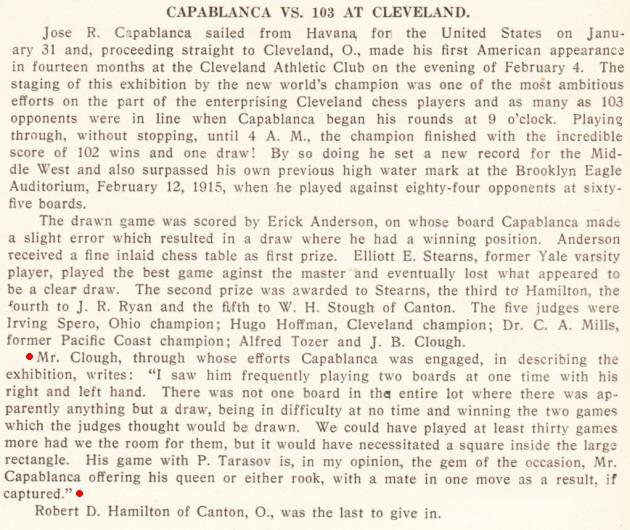
The game against Tarasov was given on page 23 of that issue of the American Chess Bulletin, on page 8 of Wonders and Curiosities of Chess by Irving Chernev (New York, 1974) and on page 118 of our monograph on Capablanca.
A comment above by J.B. Clough about Capablanca is worth highlighting:
‘I saw him frequently playing two boards at one time with his right and left hand.’
This practice of the Cuban’s was also mentioned in a report about the Cleveland display on page 9 of The Times, 22 February 1922:
‘He was frequently seen to be playing two boards at once, one with his right hand and one with his left, a little habit of his we often noticed during his simultaneous tour in this country. The player at the board he had just left made a move; over his left arm would go Capablanca’s right hand, the left maintaining hold of the piece on the board he was at, and the right hand making the necessary reply on the other board with hardly a second’s delay.’
Capablanca’s score of +102 –0 =1 may furthermore be noted in the light of a remark cited on page 317 of our book:
‘When I gave that exhibition against 103 players in Cleveland, USA early this year I had hardly touched a board for eight months and felt very hazy at the beginning, and yet towards the end I do not think my brain was ever working more clearly.’
Source: The Times, 12 July 1922, page 7 (not all editions). The text also appeared on page 464 of the Times Literary Supplement, 13 July 1922.
(8263)
Joseph Burt Clough died in Cleveland on 15 February 1936 (Cleveland Plain Dealer, 17 February 1936, page 5).
Regarding Peter P. Tarasov see C.N. 12162.
The final two paragraphs of J. du Mont’s obituary of Capablanca on pages 102-103 of the May 1942 BCM:

And from page 93 of Chess World, 1 April 1950:
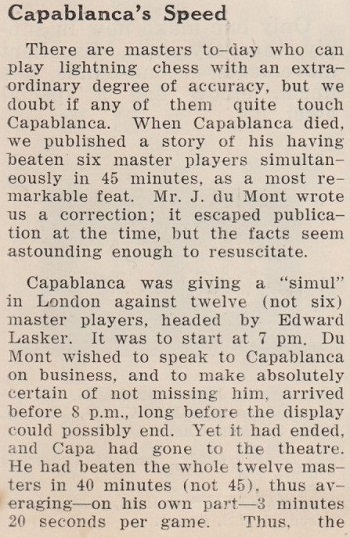
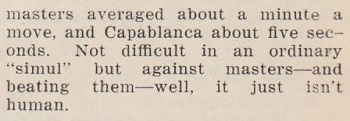
In fact, Capablanca faced seven opponents, as reported by, for instance, L. van Vliet on page 7 of the Sunday Times, 26 October 1913:
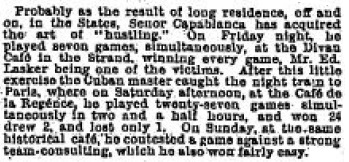
A feature article on the Cuban’s victory over Edward Lasker is Capablanca in London, 1913. Regarding the known lightning (rapid transit) games played throughout his career, see Fast Chess.
Below is a selection of photographs of Capablanca giving simultaneous exhibitions, beginning with a picture which accompanied a feature by W.H. Watts entitled ‘Worcester College for the Blind’ on pages 74-76 of Chess Pie No. 2 (1927):
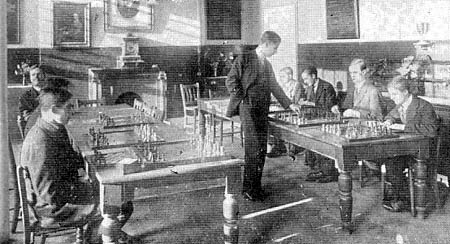
(3421)
A drawing of Capablanca which we reproduce from the Finnish newspaper (in Swedish) Dagens Tidning, 21 February 1914:
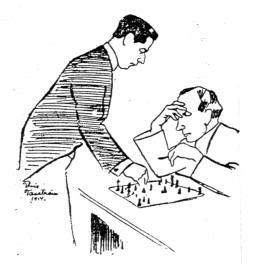
(3564)
David Zechiel (Lake Forest, CA, USA) sends the following photograph from a frail, unidentified newspaper:
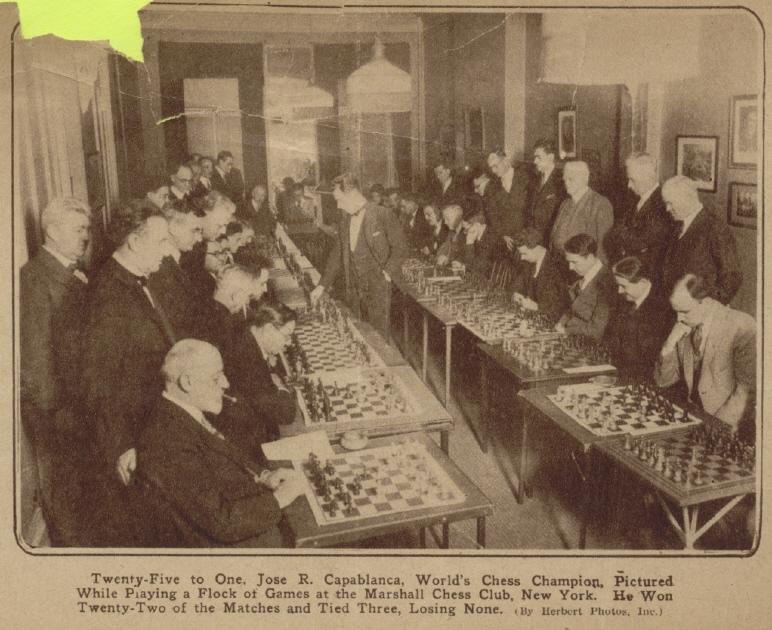
Our correspondent remarks that the figure standing second from the left is apparently Frank J. Marshall.
We can add that the occasion seems to have been the Cuban’s display on 30 November 1926. Below is the report on page 154 of the December 1926 American Chess Bulletin:
‘World champion Capablanca was in splendid trim when he encountered 25 of the members of the Marshall Chess Club in simultaneous play on the evening of 30 November. Not one of his opponents could defeat him. He won 22 and drew three against Rudolph Smirka, Milton Hanauer and Fred Reinfeld.’
(4454)
In a recent book catalogue (List Potpourri-76.4.7Is.1) Dale Brandreth commented on The Psychology of the Chess Player by Reuben Fine (New York, 1967):
‘A very interesting book, though with some very curious errors. For example, on page 50, speaking of Capablanca, he writes: “He never studied, never gave exhibitions, in fact hardly played at all outside of tournaments.” Was Fine daft? Fine himself played in Capa’s magnificent 7th Regiment Armory exhibition against 50 teams in 1931. His simultaneous exhibitions numbered in the hundreds and greatly enhanced his reputation for quick sight of the board considering the extreme rapidity of his play.’
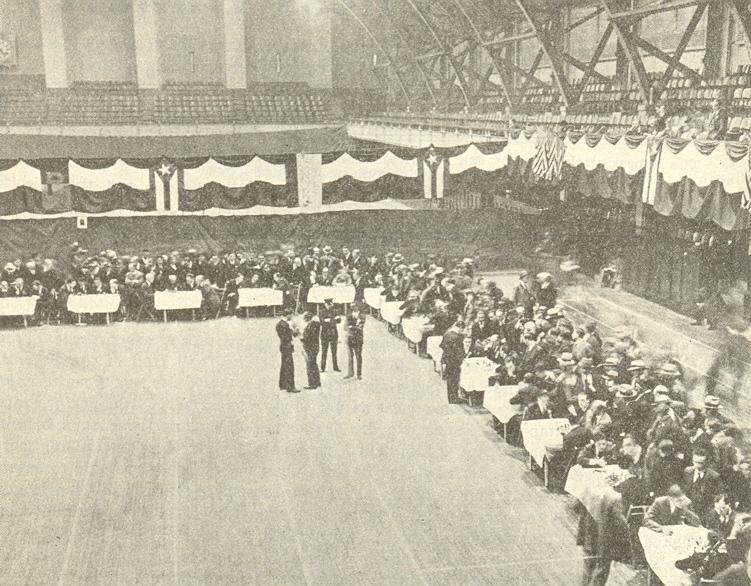
The above photograph, from page 46 of the March 1931 American Chess Bulletin, was taken during the display referred to by Dr Brandreth. Capablanca is standing at a board about half-way down the right-hand side.
(4492)
C.N. 4492 referred to Reuben Fine’s participation in a 50-board simultaneous display given by Capablanca against consulting groups at the Drill Hall of the Seventh Regiment Armory, New York on 12 February 1931, and now Tony Bronzin (Newark, DE, USA) raises the subject of Fine’s account on pages 3-6 of Lessons from My Games (New York, 1958). Fine headed the game as follows:

Our correspondent comments:
‘However, in the February 1988 Chess Life (pages 12-13) Arnold Denker, when recounting the life of an American chessplayer of the 1930s, Donald MacMurray, wrote:
“The great Cuban seemed to start out well in the game, but Mac and a young Reuben Fine showed some fine endgame technique. Defeating Capablanca was always a notable feat.’
My question is: did Fine exploit his two bishops and better king himself to win the game, or was it a collaborative effort from start to finish?’
We begin by noting that Fine’s coverage of the game had previously appeared in his series of articles ‘My Best Games of Chess’ on pages 296-297 of the October 1955 Chess Review. The game-score was given on page 56 of the March 1931 American Chess Bulletin, where the allies were named as ‘R. Fine, D. MacMurray, E. Schwartz and L.W. Stephens’. Page 50 had the same information. The display lasted nearly eight and a half hours, the final move being made ‘within a minute or two of midnight’ (page 45). Did newspapers of the time give further details of the game under discussion here?
The Bulletin published four photographs of Capablanca at other boards:
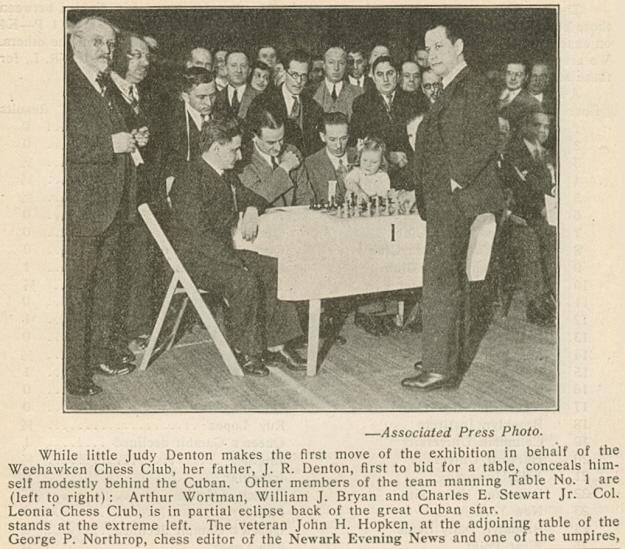
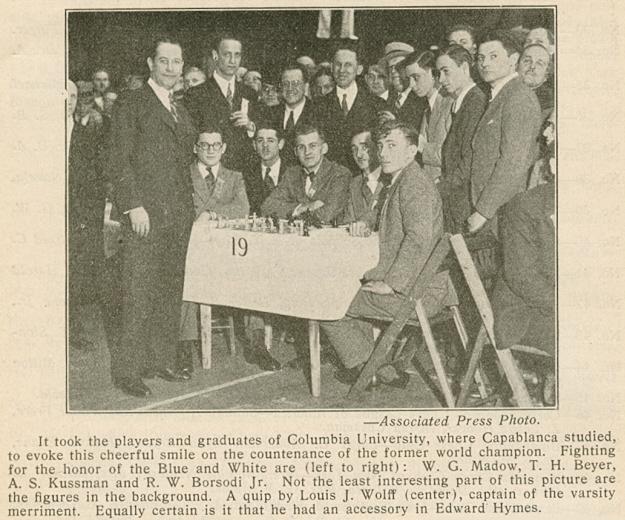
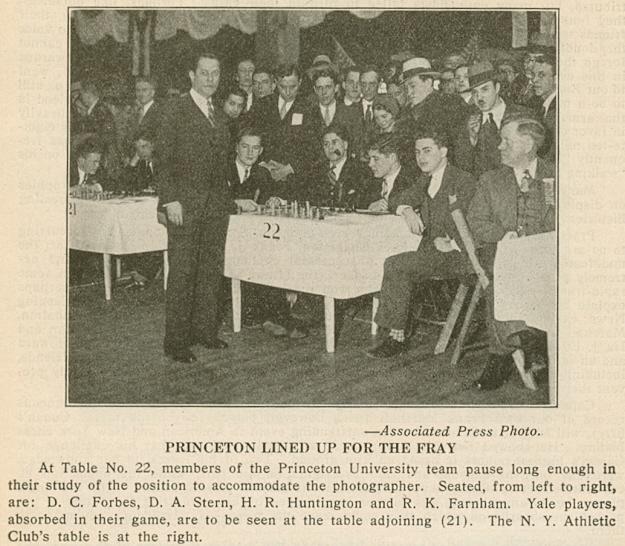
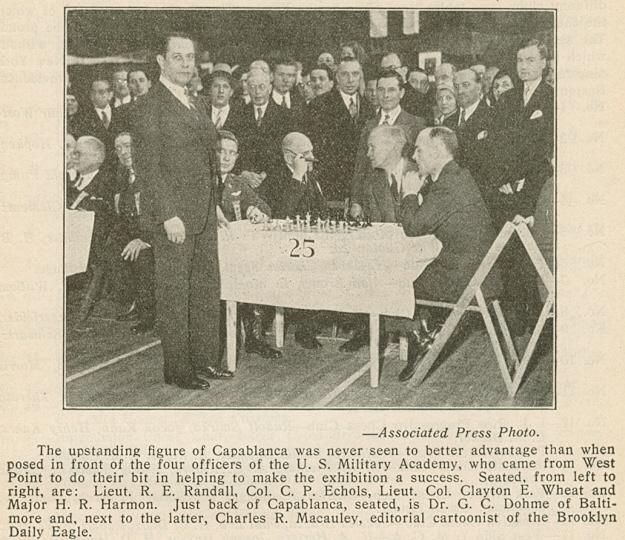
(5390)
From page 182 of the December 1922 American Chess Bulletin:
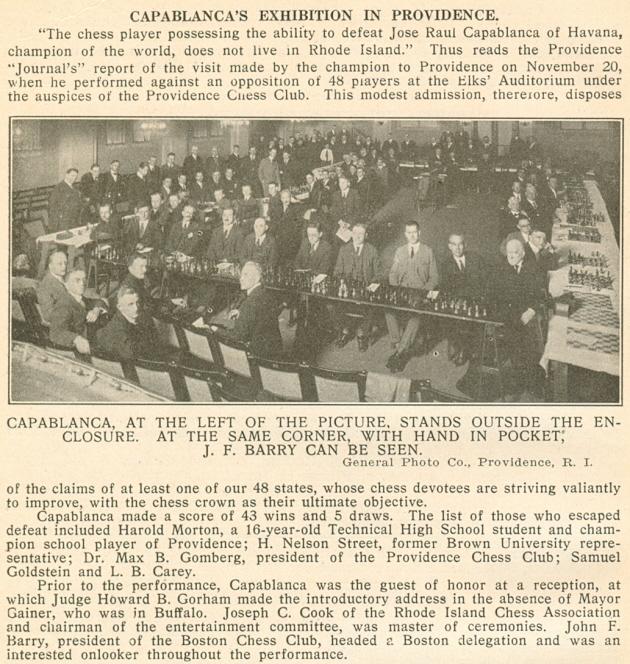
Larger version of the photograph
(6228)
From Tomasz Lissowski (Warsaw) we have received two photographs of Capablanca taken in the Polish capital in 1935:
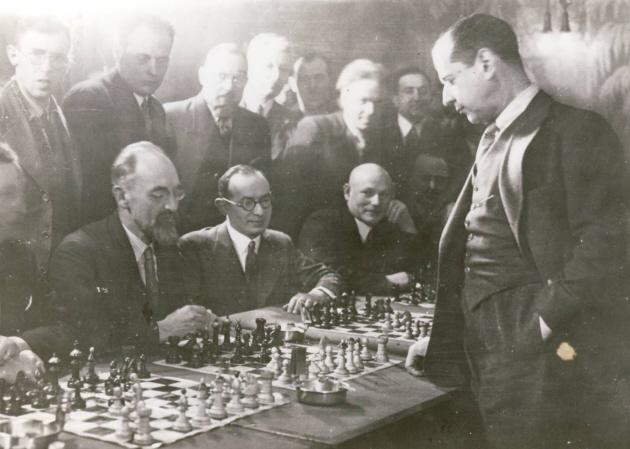
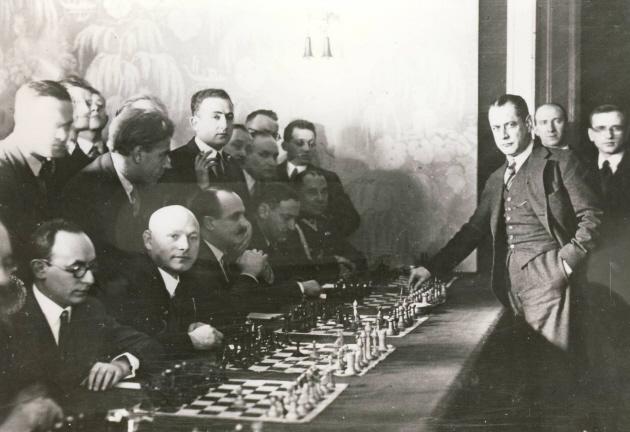
In the second photograph, our correspondent identifies the man in military uniform, seated at the back, as Colonel Marian Steifer, whose game against the Cuban has been anthologized.
(6489)
Olimpiu G. Urcan (Singapore) forwards this photograph from page 1037 of the Illustrated London News of 1 December 1928:

The person standing next to Capablanca is Mrs Arthur Rawson, the President of the Imperial Chess Club.
(7496)
Olimpiu G. Urcan sends this photograph from the fourth sheet (the photograph page) of De Sumatra Post (Medan) of 14 May 1929:
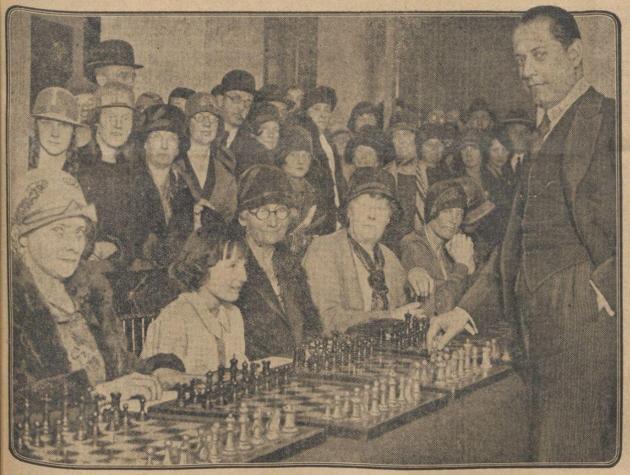

We add that the exhibition took place at the Selfridges department store in Oxford Street, London on 9 April 1929. From page 170 of the May 1929 Chess Amateur:
‘The ladies on Tuesday included the little Princess Tatiana Wiasemsky, the nine-year-old grand-daughter of Mr Gordon Selfridge. She made a good fight and was one of the last to finish.’
Another photograph taken during the display, and also showing ‘the little Princess’, is in our book on Capablanca, courtesy of Mr David Butler of Selfridges:
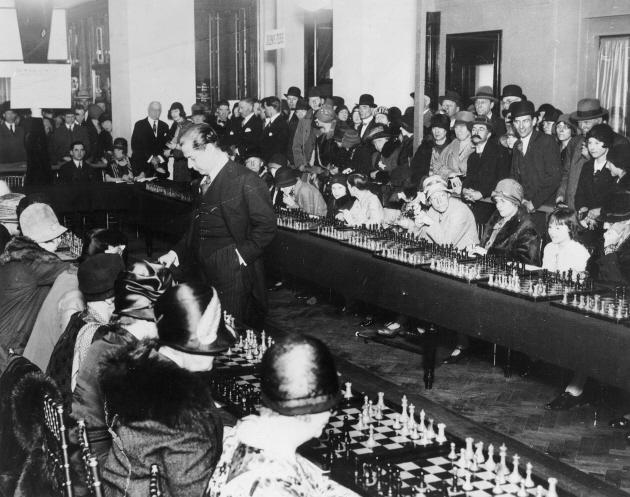
(7633)
The first photographin C.N. 7633 showed Princess Tatiana Wiasemsky/Wiazemsky. A further picture, from page 9 of the Sheffield Daily Telegraph, 2 May 1929:
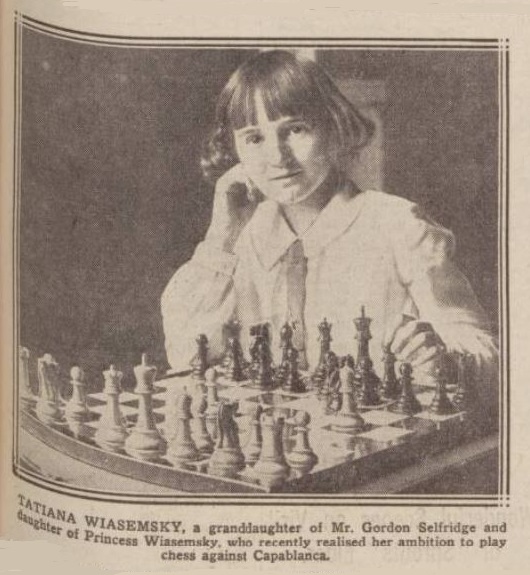
(10860)
From page 29 of Famous Chess Players by Peter Morris Lerner (Minneapolis, 1973):
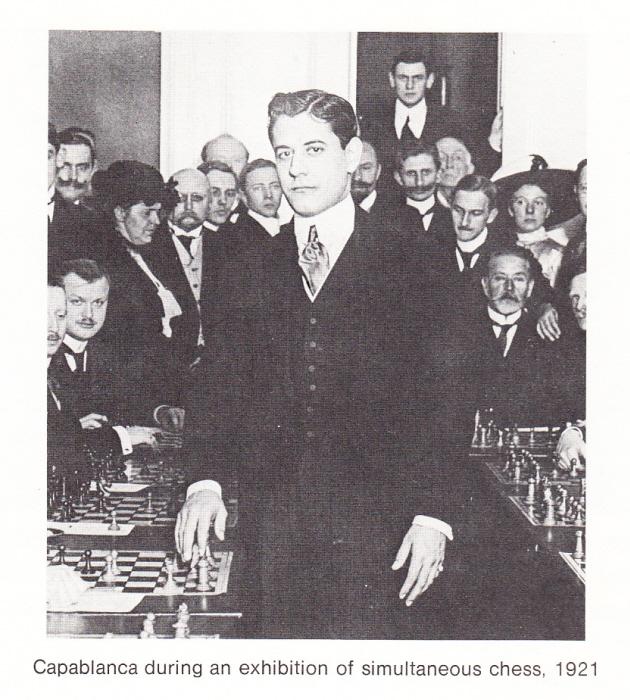
Despite also appearing on page 5, the year ‘1921’ is obviously wrong since Capablanca in the photograph is much younger. Moreover, the picture (uncropped) had been published on page 13 of Bohemia, 20 January 1918. The caption in the Cuban publication offered no date but stated that the simultaneous exhibition had been in Berlin.
(7704)
C.N. 11296 gave the following, from page 9 of the 29 April 1916 edition of the Wiener Illustrierte Zeitung:
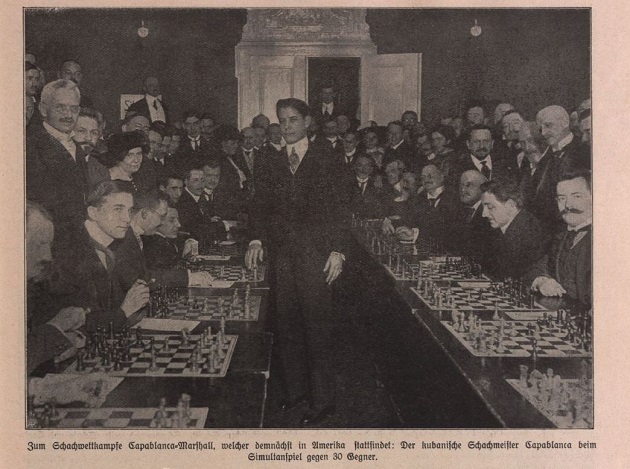
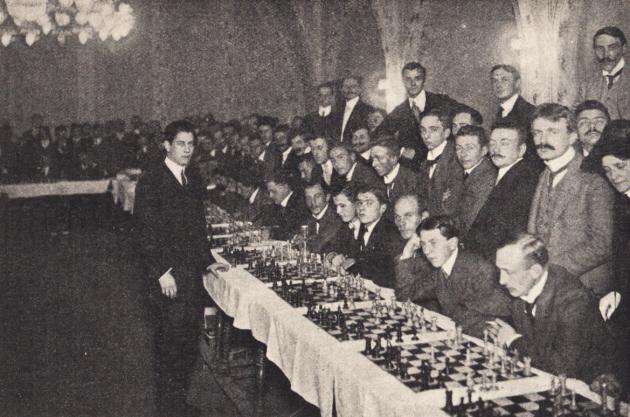
Source: Časopis českých šachistů, 1911, page 189.
(7862)
Gerard Killoran (Ilkley, England) draws attention to the photographs of Capablanca giving simultaneous exhibitions in the Illustrated World (1919), page 934, and the New York Times Pictorial Portfolio of the World (1922), page 410. The latter publication also has a fine portrait of Reshevsky.
(9479)
Eduardo Bauzá Mercére (New York, NY, USA) sends two photographs (references: AR_AGN_DDF/Consulta_INV: 126775 and AR_AGN_DDF/Consulta_INV: 126774) from Argentina’s Archivo General de la Nación, courtesy of the Ministerio del Interior, Obras Públicas y Vivienda. They show simultaneous exhibitions by Capablanca in Buenos Aires on 7 May 1911 (30 boards) and 29 June 1911 (40 boards).
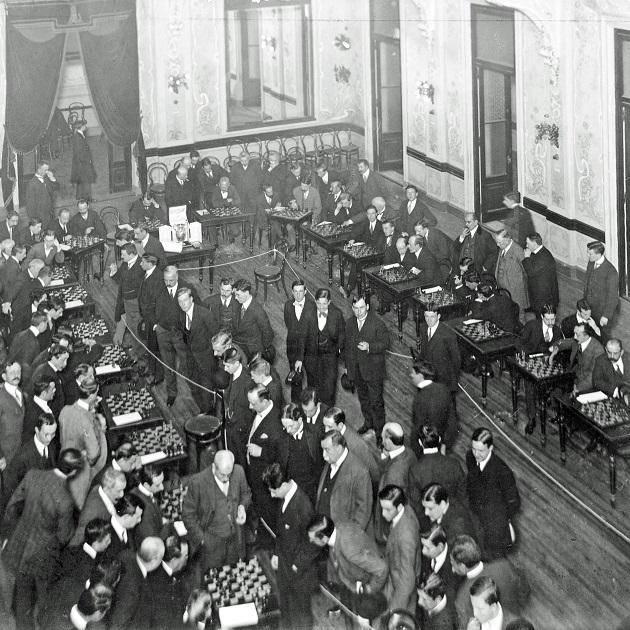
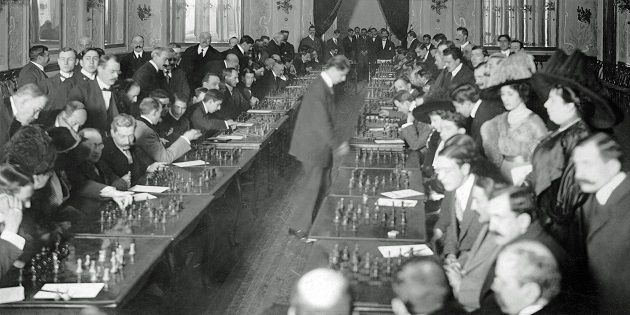
(10648)
This photograph from opposite page 40 of the Revista del Club Argentino de Ajedrez, April-June 1911 has been provided by the Cleveland Public Library:
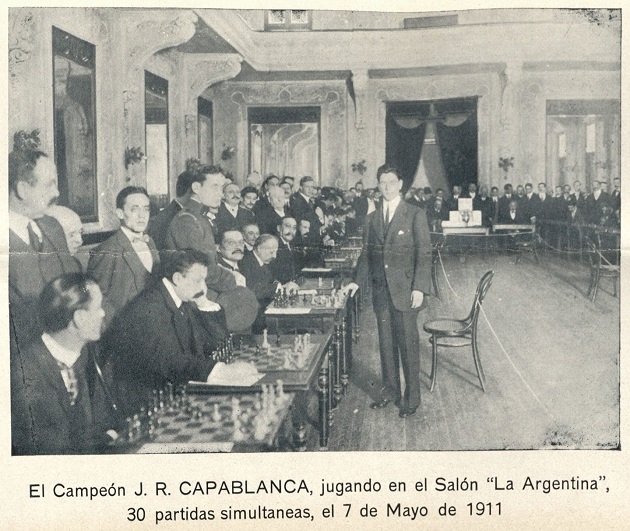
(10719)
From page 8 of the Buffalo Enquirer, 23 November 1909:
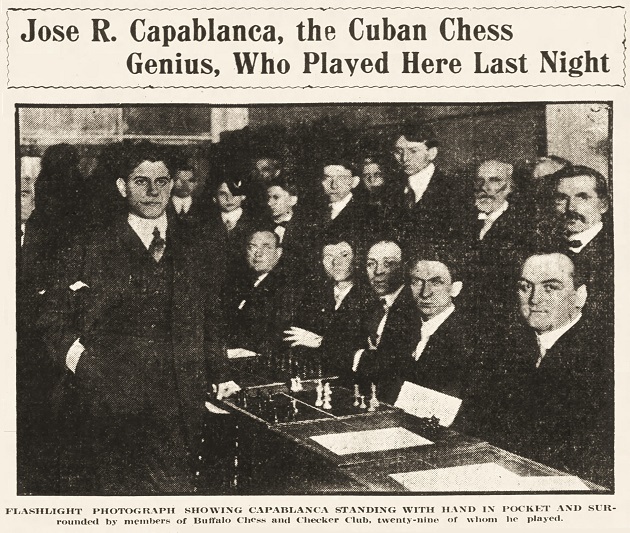
(10952)
Olimpiu G. Urcan sends this cutting from page 7 of the Liverpool Weekly Courier, 4 October 1919:
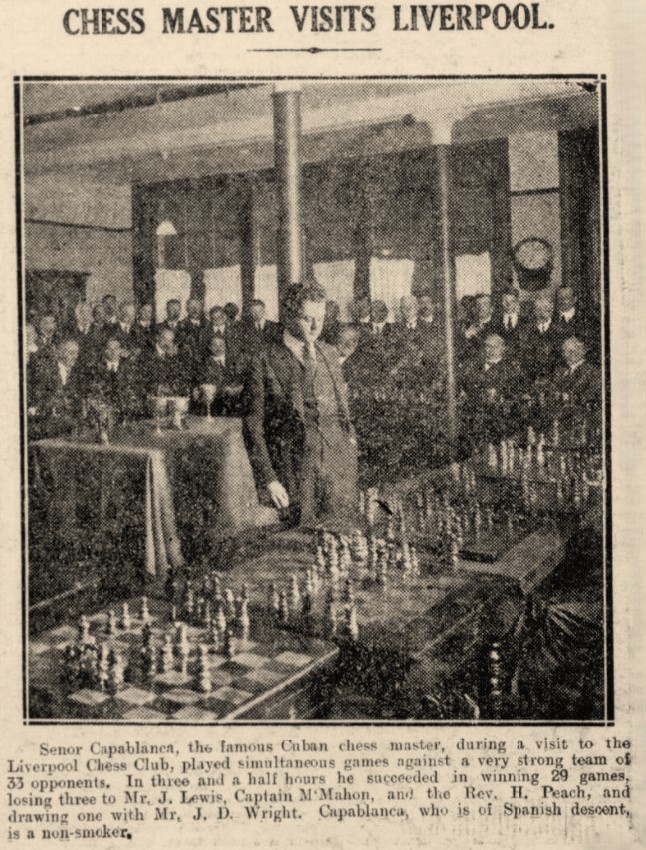
The display was on 27 September 1919.
(12199)
To the Chess Notes main page.
To the Archives for other feature articles.
Copyright: Edward Winter. All rights reserved.